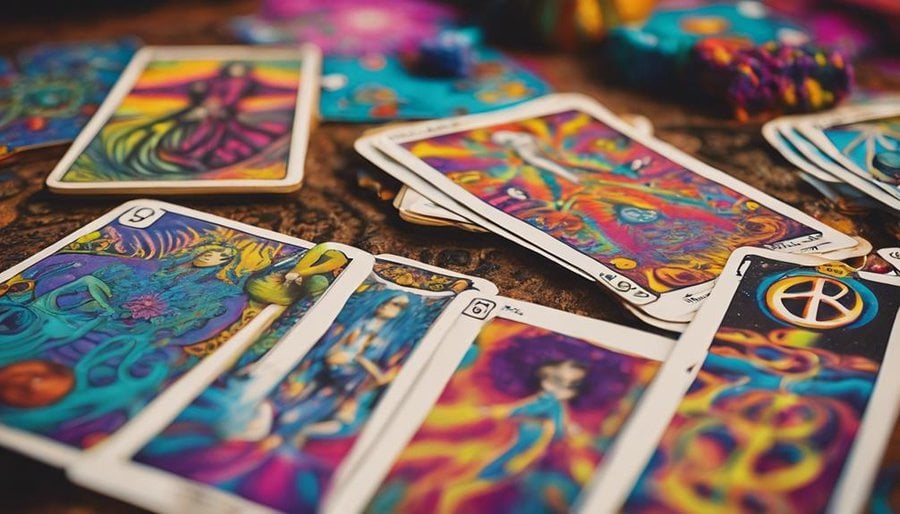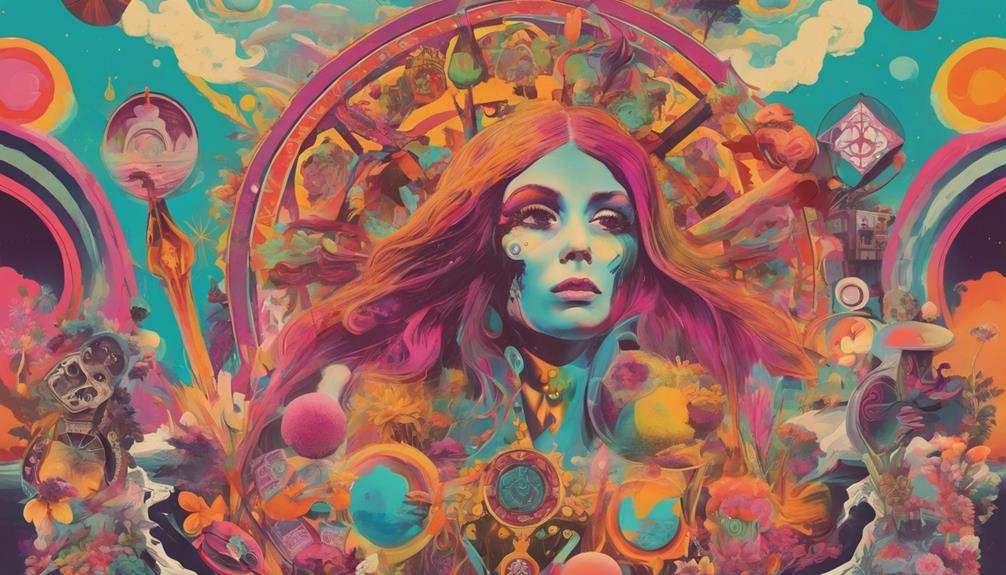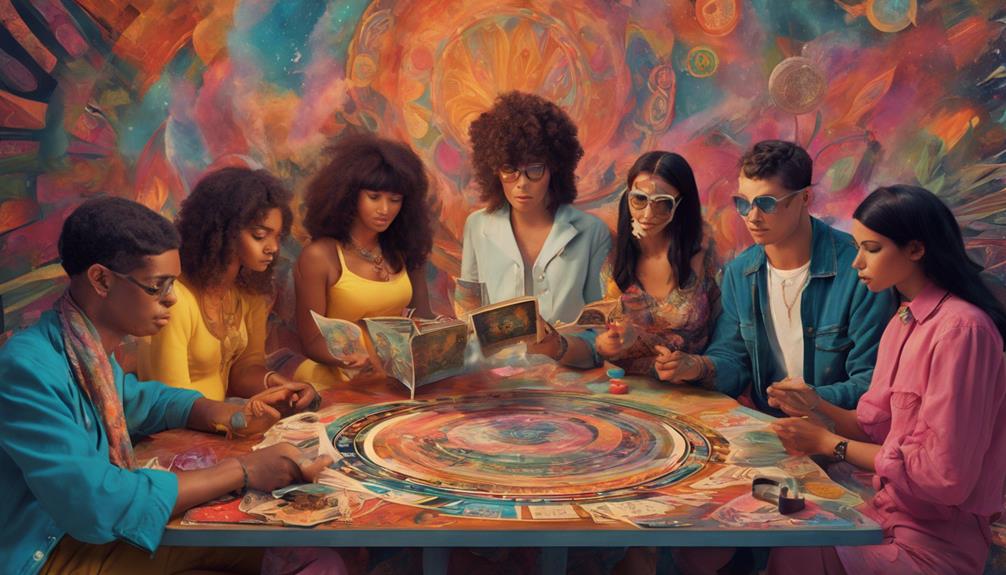What the 1960s Counterculture Movement Did for Tarot’s Popularity

The counterculture embraced Tarot as a tool for expanding consciousness and exploring spirituality, leading to increased interest in esoteric practices and divination methods. This cultural shift sparked a resurgence of Tarot's popularity, with many people turning to these ancient cards for guidance and self-discovery.
The Tarot's symbolic imagery and archetypal meanings resonated with individuals seeking deeper meaning and connection in a rapidly changing world. Its ability to tap into the subconscious mind and provide intuitive guidance appealed to those looking for answers beyond traditional sources.
Origins of Tarot Reading
The origins of Tarot reading can be traced back to the 15th century in Europe, where the cards were initially used for playing games before evolving into a tool for divination and spiritual guidance. This intricate history intertwines with mysticism, as the Tarot deck, comprised of both major and minor arcana, gained recognition not only for its gaming purposes but also for its enigmatic symbolism and deeper meanings. As the centuries passed, the Tarot deck became increasingly associated with esoteric traditions, drawing interest from mystics, occultists, and spiritual seekers seeking insights beyond the physical dimension.
Through the lens of history, the evolution of Tarot reading reveals a journey of spiritual exploration and self-discovery. Each card carries a story, a lesson, a reflection of the human experience, inviting individuals to explore into the dimensions of subconscious thoughts and emotions. The mysticism embedded within the Tarot deck transcends time, offering a pathway to introspection and enlightenment for those who seek to reveal its profound wisdom.
Tarot's Alignment With Counterculture Ideals
The alignment of Tarot with counterculture ideals during the 1960s was a harmonious union that resonated with the movement's emphasis on spirituality, self-discovery, and alternative belief systems.
Tarot served as more than just a tool for divination; it became a symbolic language that allowed individuals to explore deeper aspects of themselves and the world around them.
Its rich symbolism and mystical allure appealed to those seeking a connection to something beyond the conventional norms of society.
Counterculture's Influence on Tarot
During the 1960s, a harmonious convergence between the counterculture movement and the tarot emerged, reflecting shared values and ideals.
Tarot's modern applications found resonance within the counterculture impact, serving as a tool for introspection, self-discovery, and challenging conventional norms.
The counterculture's emphasis on individuality and non-conformity intertwined with tarot's role in social change, fostering a sense of empowerment and autonomy among its followers.
Through its imagery and symbolism, tarot provided a platform for exploring alternative perspectives and spiritual paths, aligning with the counterculture's quest for authenticity and freedom.
This connection between the counterculture movement and tarot not only bolstered the popularity of tarot but also enriched its significance as a catalyst for personal transformation and social evolution.
Tarot as Spiritual Tool
In the symbiotic relationship between the counterculture movement and tarot, the spiritual essence of tarot card readings emerged as a transformative tool embodying the ideals of non-conformity and introspection. Tarot became a vessel for spiritual awakening, guiding individuals towards a deeper understanding of self and the universe.
Through tarot, seekers sought a cosmic connection, transcending societal norms to explore their inner truths. This spiritual tool offered a path to enlightenment, encouraging individuals to break free from conventional thinking and embrace their authentic selves.
The counterculture movement embraced tarot's ability to unveil hidden wisdom and foster a sense of unity with the cosmos, making it a powerful instrument for personal growth and self-discovery.
Tarot's Symbolism Appeal
With its rich symbolism deeply resonating with themes of non-conformity and introspection, tarot swiftly aligned with the counterculture ideals of the 1960s, becoming a potent tool for self-discovery and rebellion.
The symbolic imagery woven into each card allowed individuals to explore unconventional paths and challenge societal norms, fostering a sense of empowerment and autonomy.
Tarot's appeal lay not only in its mystical allure but also in its ability to serve as a mirror for the inner workings of the human psyche, inviting introspection and personal growth.
Tarot as a Tool for Self-Discovery
Tarot, with its intricate symbolism and archetypes, serves as a mirror for individuals to explore their innermost thoughts and emotions. Through the cards, people can commence on a journey of personal growth, gaining insights into themselves and their life paths.
The practice of tarot offers a unique opportunity for introspection and self-discovery, guiding individuals towards greater self-awareness and understanding.
Personal Growth Through Tarot
Beginning on a journey of self-discovery through the use of Tarot reveals profound insights into one's inner thoughts and emotions. Tarot cards serve as mirrors reflecting the seeker's innermost desires, fears, and aspirations. Through this introspective practice, individuals often experience:
- Personal Transformation: Embracing change and growth with openness and courage.
- Spiritual Growth: Connecting with a higher power or inner wisdom for guidance.
- Inner Exploration: Delving deep into the psyche to uncover hidden truths and untapped potential.
In the quest for self-awareness, Tarot becomes a sacred tool, inviting seekers to explore the depths of their souls and commence on a transformative journey towards personal enlightenment and empowerment.
Inner Reflection With Tarot
Commencing on a journey of self-discovery through Tarot offers individuals a profound opportunity for inner reflection and personal growth. Tarot serves as a meditative practice, allowing one to explore deep within themselves, investigating the vast landscapes of their subconscious mind. Through the symbolism present in the cards, individuals can engage in spiritual exploration, connecting with their innermost thoughts and emotions. This introspective process aids in uncovering hidden truths, guiding individuals towards a greater understanding of themselves and their life's path. By using Tarot for inner reflection, individuals can navigate challenges, embrace personal strengths, and cultivate a sense of self-awareness that propels them towards a more fulfilling existence.
| Benefits of Using Tarot for Inner Reflection | Description |
|---|---|
| Self-discovery | Engage in introspection and uncover hidden truths |
| Personal Growth | Foster self-awareness and navigate life challenges |
| Spiritual Exploration | Connect with inner thoughts and emotions |
| Meditative Practice | Explore deep within oneself for inner reflection |
Tarot's Visual Appeal in the 1960s

During the 1960s, the visual allure of Tarot cards fascinated the counterculture generation, drawing them into a mystical world of symbolism and hidden meanings. The psychedelic and vibrant 1960s aesthetics merged seamlessly with the intricate visual storytelling of Tarot decks, creating a mesmerizing experience for those seeking deeper insights into themselves and the world around them.
In this era of heightened creativity and exploration, Tarot's visual appeal played a pivotal role in shaping its popularity among the counterculture. Here's why:
- Colorful Imagery: Tarot cards burst with a kaleidoscope of colors, reflecting the bold and vivid spirit of the 1960s, enchanting the imagination of seekers.
- Symbolic Depth: Each symbol and illustration on the Tarot cards held layers of meaning, inviting individuals to explore the depths of their subconscious and uncover universal truths.
- Artistic Revolution: The artistic revolution of the 1960s found a perfect canvas in Tarot decks, offering a fusion of creativity, spirituality, and rebellion that resonated with the free-spirited souls of that era.
Tarot's Integration Into Popular Culture
The mesmerizing fusion of Tarot's symbolic richness and the counterculture's vibrant spirit seamlessly paved the way for its integration into popular culture. Tarot's mainstream appeal has transcended its esoteric origins to become a prevalent feature in today's cultural landscape. Its allure lies in the intricate tapestry of archetypes, mystique, and introspection that it weaves, resonating with individuals seeking deeper insights and connections.
Tarot's cultural impact is undeniable, permeating music, art, literature, and even fashion. From album covers to fashion runways, Tarot symbols are prominently displayed, embodying a sense of mystery and enchantment that captivates audiences worldwide. Its presence in mainstream media reflects a growing fascination with the mystical and spiritual domains, inviting exploration and contemplation.
As Tarot continues to influence and inspire, its integration into popular culture serves as a testimony to the enduring power of its symbolism and the timeless quest for self-discovery. Embraced by diverse communities and embraced by a generation hungry for meaning, Tarot remains a potent symbol of liberation and enlightenment.
Influence of Counterculture Icons on Tarot
In the domain of Tarot's evolution, counterculture icons have left an indelible mark, infusing the mystical tradition with rebellious spirit and fresh interpretations. The influence of these icons on Tarot can be seen in various ways:
- Tarot's Mainstream Appeal: Counterculture figures brought Tarot out of the shadows, making it more accessible to the general public. This shift helped Tarot move from a niche interest to a mainstream phenomenon, enchanting a broader audience seeking unconventional wisdom.
- Cultural Impact: Icons of the counterculture era introduced Tarot as a tool for self-discovery and empowerment, aligning it with the values of freedom, individuality, and non-conformity. This cultural impact reshaped how Tarot was perceived, transforming it into a symbol of rebellion and alternative spirituality.
- Symbolic Revolution: Counterculture icons redefined the symbols within Tarot cards, imbuing them with new meanings that resonated with the era's ethos of questioning authority and embracing change. This symbolic revolution breathed fresh life into Tarot, making it a mirror of the turbulent times it reflected.
Tarot's Evolution Post-1960s
With the counterculture movement of the 1960s paving the way for Tarot's newfound popularity and reinterpretation, the evolution of Tarot post-1960s continued to reflect shifting societal values and spiritual perspectives. Tarot's contemporary appeal lies in its ability to adapt to the changing cultural landscape while still retaining its mystical essence. This adaptability has allowed Tarot to remain relevant in modern times, appealing to a diverse range of individuals seeking guidance, introspection, and spiritual connection. Its cultural significance has expanded beyond its historical roots, with Tarot decks now incorporating themes from popular culture, mythology, and diverse spiritual traditions. This evolution post-1960s has seen Tarot become not just a tool for divination but a reflection of the collective consciousness, mirroring the ever-evolving human experience.
| Tarot's Evolution Post-1960s | |
|---|---|
| Contemporary Appeal | Cultural Significance |
| Adaptable to modern culture | Reflects shifting societal values |
| Appeals to diverse individuals | Incorporates popular culture and mythology |
| Provides guidance and introspection | Mirrors the collective consciousness |
Tarot's Modern Resurgence and Relevance

Embracing the zeitgeist of modern spirituality, Tarot's resurgence and relevance today embody a timeless connection to the human quest for meaning and insight. In a world seeking liberation and self-discovery, Tarot has found a new place, offering profound wisdom and guidance to those who seek it. Here are three reasons why Tarot has become increasingly relevant in the modern era:
- Tarot Therapy: Through the intricate symbolism of the cards, individuals can explore deep into their subconscious, revealing hidden emotions and experiences. This therapeutic approach allows for healing and self-reflection in a unique and transformative way.
- Tarot Psychology: The archetypes and imagery present in Tarot cards provide a rich tapestry for exploring the depths of human psychology. By tapping into these universal symbols, individuals can gain insights into their behaviors, motivations, and inner conflicts.
- Empowerment and Freedom: Tarot's resurgence offers individuals a sense of empowerment and freedom to navigate life's complexities. It serves as a tool for self-empowerment, encouraging individuals to trust their intuition and make decisions aligned with their true selves.
Frequently Asked Questions
How Did the 1960s Counterculture Movement Specifically Influence the Design of Tarot Cards?
The 1960s counterculture movement deeply influenced the design of tarot cards. Its embrace of unconventional thinking and symbolism sparked a reimagining of traditional tarot imagery, leading to more diverse and influential designs that resonated with a broader audience.
Were There Any Controversies Surrounding the Use of Tarot Cards During the 1960s Counterculture Movement?
During the 1960s counterculture movement, tarot interpretations faced controversies due to perceived occult associations. Some viewed tarot as controversial practices, questioning its validity and influence on societal norms. The era's embrace of non-traditional beliefs stirred debates over tarot's role in spirituality.
Did Any Famous Musicians or Artists From the 1960s Counterculture Movement Publicly Endorse the Use of Tarot Cards?
In the artistic swirl of the 1960s counterculture movement, famous endorsements of tarot cards shimmered like stars in a dark sky. Musicians and artists, drawn to the mystical allure, embraced the Tarot's influence with open hearts.
How Did the Mainstream Media React to the Growing Popularity of Tarot During the 1960s Counterculture Movement?
Mainstream media reception of tarot during the 1960s counterculture movement was mixed. While some outlets sensationalized it, others viewed it with skepticism. Public perceptions varied, with some embracing tarot's mystique and others dismissing it as mere superstition.
Are There Any Specific Tarot Decks That Gained Popularity During the 1960s Counterculture Movement That Are Still Widely Used Today?
In the world of Tarot Decks, some Popular Designs from the 1960s counterculture movement continue to captivate modern users. One such example is the iconic Rider-Waite-Smith deck, cherished for its timeless symbolism and widespread influence.











